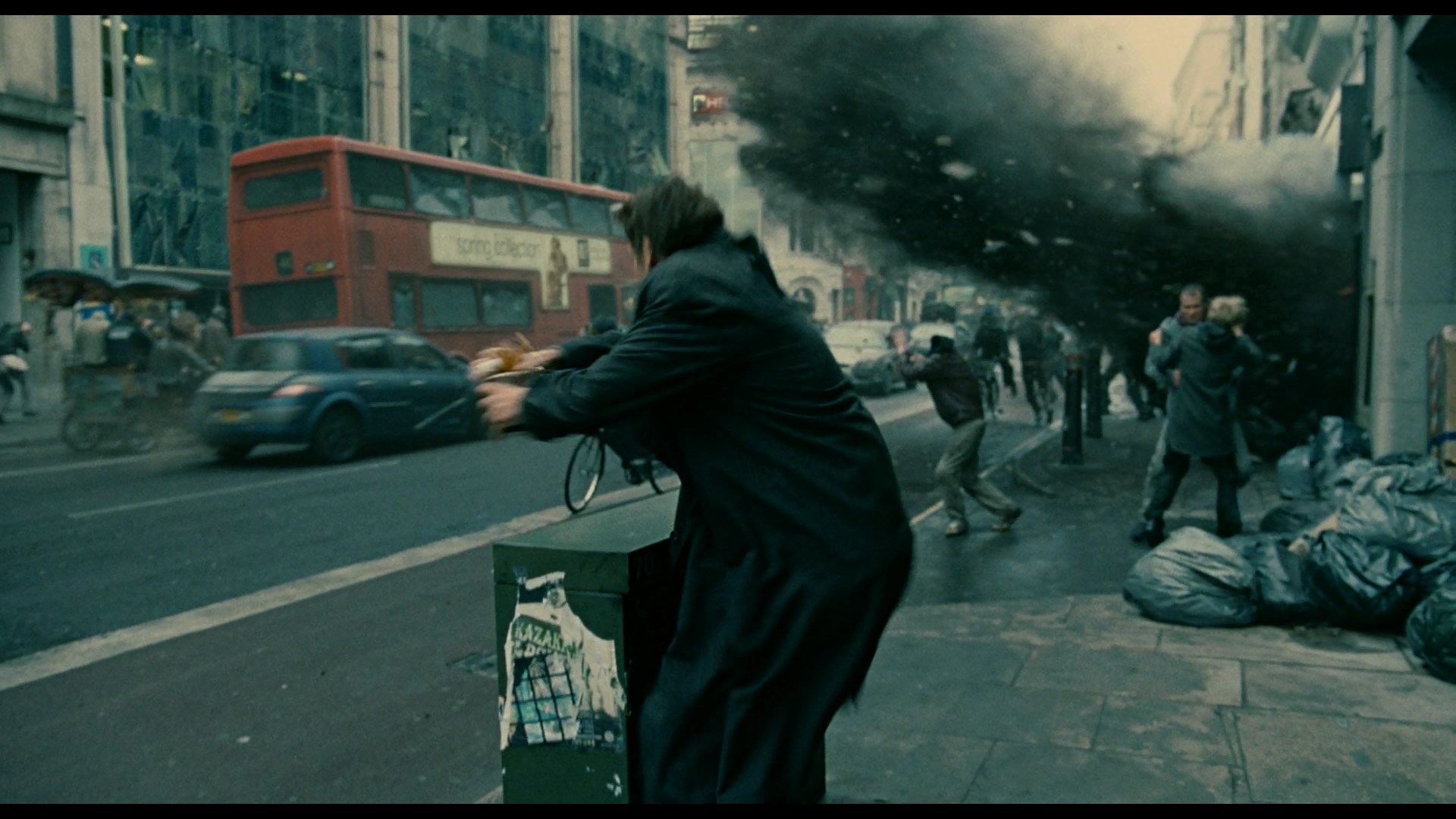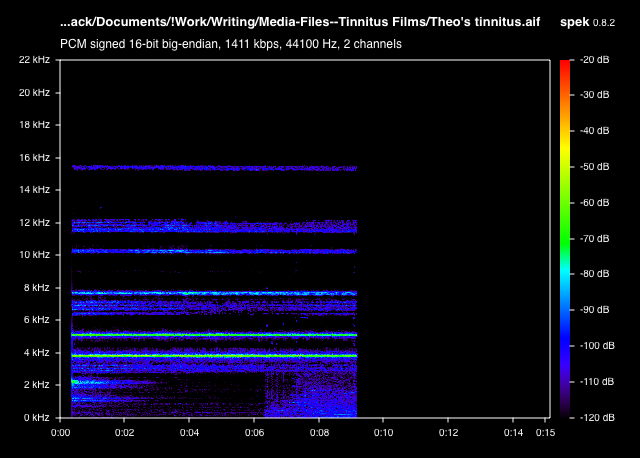The effect of tinnitus in the movies
 In a first-person narrative film, there was an explosion. Visually on the screen you can see a bunch of debris, clouds of smoke, bright flashes. But something unusual happens on the audio track. Suddenly, there is complete silence, through which the noise gradually begins to show through: the cries of people, gunfire, and other explosions. Noise increases, there may be slow motion on the screen. During a few seconds of deathly silence, a high-frequency ringing, whistling, buzzing is heard. Finally, agonizing seconds reveal the trauma of the character. He restores his feelings, gathers strength into a ball and continues to act.
In a first-person narrative film, there was an explosion. Visually on the screen you can see a bunch of debris, clouds of smoke, bright flashes. But something unusual happens on the audio track. Suddenly, there is complete silence, through which the noise gradually begins to show through: the cries of people, gunfire, and other explosions. Noise increases, there may be slow motion on the screen. During a few seconds of deathly silence, a high-frequency ringing, whistling, buzzing is heard. Finally, agonizing seconds reveal the trauma of the character. He restores his feelings, gathers strength into a ball and continues to act.Cinema has been around for over a hundred years. But this method of creating an audio trauma has become widespread relatively recently - at the beginning of this century. Why?
Theory
The effect depicted is not fiction. Weapons and even more so the bombing is a very loud process. Ear protection does not exist for the sake of beauty. Subjected to the noise of a shot (about 140 decibels) risks losing some hearing. And it hurts. Gags carry almost any shooter, and gun enthusiasts often spend good money on protecting their ears. For professional soldiers and veterans of high-profile employment, hearing loss is common.
The scene of an explosion in a cafe, "Child of Man"
')
Many works of culture do not want to dwell on the image of realistic characters. They resort to images, often giving them too much strength. Heroes of the action movie - no matter the film or video games - jump, hung with weapons, shoot well, and either avoid the enemy bullets or stand the shots of foes. And this is normal: the viewer or player wants this. Of course, commandos never wear ear protection. If someone covers their ears, then these are weak cowardly characters or women. In real macho, the eardrum is at least steel.
Other settings suggest realism. In them, the characters have weak bodies of bones and meat, and from this more interesting characters. In such a movie, hearing loss occurs.
Tinnitus is the illusion of ringing in the ears, a sound that is not really there. Most often, this sound is a high-frequency ringing. Noise can occur for a variety of reasons, from infections to problems in the brain. Often chronic tinnitus develops from loud noises. The heroine of the film “The Child of Man ” makes a very poetic diagnosis: it is a swan song of dying cells in the ear. When the end comes, they will never hear this frequency again. Therefore, it is better to enjoy ringing while it is there.
It is difficult to expect a good otology lesson from a feature film. The real mechanism of ringing is not so beautiful, and it works differently. The hair cells in the cochlea lose their ability to hear right away. The effect comes from adaptation to loss. The brain does not just hear worse, but compensates for the lost ability to hear, which is expressed in constant ringing. Visitors to concerts and loud musical events not only lose their hearing, but also acquire this whistle. For the rest of their lives, they recall with nostalgia the days when one could hear silence. Whistling goes day and night, without stopping.
To the cinema
In the movies, the ringing does not go all the time. It rarely lasts a minute or more. The whistle begins after an explosion or a shot near the ear, but calms down. Although tinnitus also occurs from other diseases and disorders of the hearing aid, in the movie it is primarily a symptom of injury. What does this effect allow to achieve, apart from demonstrating the vulnerability of the hearing aid?
Here we need to recall the classical techniques of noir, in which the narration is conducted in the first person. Behind the frame sounds the voice of the main character. Sometimes someone else's voice sounds. However, any voice is always a stranger, even an internal monologue. Even the voice that we think is alien, because in fact we do not control it. A real person is just a listener of someone else’s voice in his head.

But the inner monologue can stop. There comes a complete emptiness. Of course, it rings. The tinnitus effect is the song of the neurons in our brain. It shows the chilling materiality of the structure of the main character's consciousness. An inner monologue is a first-person narrative. Tinnitus is a level lower in the consciousness of the hero, it is the empty sound of his brain, the howl of the unconscious component of his mind.
That is why the ringing effect sometimes goes beyond the borders of the militants and ends up in drama. For example, it can be found in the first series of “Breaking Bad” / Breaking Bad, when the central character tries to come to terms with the idea of a cancerous tumor in his own lungs.
Having passed a series of battles and who saw death with his own eyes, he acquires an unusual, detached, unfocused look, which is called a look at a thousand yards. Tinnitus is the audio version of combat trauma and post-traumatic stress disorder.
Spread
The effect was especially prevalent only in the past decade. McHagud has led the distribution by year.

The ringing was noticed in the comedy “ The Out-of-Towners” of 1970, but the ears of the viewer knew the peace from the squeak three more decades after. Exceptions are few. A classic example is " Go and See " Elem Klimov. The silent movie is intentionally played with loud noises. Tinnitus is one of the least injuries that Fleur faces.
Most often, the 1998 film “Saving Private Ryan” is called the earliest example of tinnitus in the cinema, although even in the US the first effect was mastered in 1997 by “The Policemen ”. Only by 2003, the ringing was put on stream. An avid movie fan in his ears began to whistle at least two or three times a year.
Technical component
Tinnitus is a subjective sensation. It is impossible to measure the illusory ringing in the ears of others. You can only create a similarity that will reflect the real trauma of hearing. Today, the implementation of the effect does not raise questions: it is a low-pass filter to the rest of the sounds and a sine wave in the region, for example, three kilohertz. The first drowns out the noise in the background, the person is as if stunned. The second for the effect - this is ringing in the ears. Specific implementations vary, the general principle remains the same.

Robert Walker, in his book Reverberations: The Philosophy, Aesthetics and Politics of Noise, argues that the technical component was a barrier to the emergence of tinnitus in cinema. He says that only with the spread of Dolby noise cancellation in the mid-70s was it possible to add such a frequency. Prior to this, the equalization of the Academy Curve, which cut off frequencies above 5-8 kilohertz, was common. Therefore, the audience could not distinguish tinnitus from the poor quality of the audio system.
Mack Hagud denies this. Indeed, in the "Newcomers" of 1970, the ringing was: these were two frequencies of 1.6 and 2.3 kHz. As Hagud showed in the spectrogram above, in the 2006 film “Child of Man” there is some kind of weak activity in the 8 kHz tinnitus scene, but the main frequency is around 3.9 kHz. Such a thing could be realized even before the seventies, albeit with insignificant losses.
Whether the sound of the terrorist attack of September 11, 2001 and the war in Iraq that followed it, or the new technical capabilities secured tinnitus in the movie's arsenal. From there, he migrated to video games: Half-Life 2, Call of Duty 2, Saints Row 2, Battlefield 2, Fallout 3, and other shooters are trying to portray a short-term hearing loss. This is usually done by the same “cinema” formula.
But ringing is also a tool for demonstrating the fragility of the human mind. Sometimes the authors aim to highlight the internal vulnerability of the main character. The hero of the middle of the last century would rely in this on catchy internal monologues. Today, cinema is increasingly resorting to the ringing silence of acoustic trauma.
Source: https://habr.com/ru/post/393729/
All Articles